Ješa Denegri
BOGOLJUB JOVANOVIĆ AND THE REALISATION OF INDIVIDUAL FREEDOM THROUGH UNCOMPROMISING ART
At the exhibition in the Rima Gallery, with only a few exceptions, there will be shown for the first time his small format works on paper, seriously damaged but subsequently restored exceptionally well so that they can now be definitely included into the artist’s overall opus. Their titles are: Tomorrow Will Be Too Late (self–portrait), Everyman for Himself, Sour Puss Magicians dated on the back 23 XI 51. Then there are Orator’s Gesture, A Big Bite, Voice, Syringe, The Spring Is Springing Forth, Seven Seals, Underlined, Wake, Dok...(incomplete title), Now I Am Alone, All That Glitters Is Not Gold, Unnecessary Harshness, Cross, An Honest Man, Tears, Useful Trick, Lapsus Lingue, A Merry Heart Bears No Evil, At the Same Task, Proverb I, Proverb II; all the titles are written in big Cyrillic letters over the scene and there are some untitled ones. They all belong to the artist’s early Belgrade period from about 1950 to 1953, to the cycles of Proverbs and Magicians or to the works made at the same time and related to them, with all the characteristics of thematic and visual features of those cycles, confirming and enhancing the appraisals of Jovanović’s art from its Belgrade beginnings and his first shows from 1953 supported by Zoran Mišić and Vasko Popa in their catalogue prefaces.
The series of bigger format works (most frequently 58.5x73.5 cm) in the technique of coloured ink and wax on paper, entitled A Eunuch Prince, Astronomer Punished, Stupid Cupid, Slight Error of Judgememt (the only one precisely dated on the back 15 II 1962) – and judging by some titles in English – were most probably made during the first years of artist’s stay in America, in the early 1960s (and not the seventies and eighties). Like other works from the same period these show scenes motivated by the reasons known only to the artist and confront the viewers with the dilemmas that cannot be solved but also make them aware that they are in front of an opus of irresistibly convincing and uncontroversial values.
„The case“ of Bogoljub Jovanović is unique in the Serbian art from the second half of the twentieth century. With his two solo shows in 1953 he was present and perceived in the local artistic scene of the early fifties, but with his departure for Paris and New York, where he was not able to adjust to the public artistic life of the environment, he practically disappeared and for a long time his output was known only in fragments. He has realised a relatively modest opus (if one excludes the numerous beginner’s student drawings) reduced to three problematic chapters; cycles of gouaches from the early fifties, the abstract K–55 painting and the combined techniques from the sixties. A historic survey of Jovanović’s artistic legacy was gradual and slow, full of understanding and respect towards his specific „case“, but it has not been completed and there is still enough space for further problematic interpretations. It seems quite certain today that he has marked a definite conception of art in the early post–war cultural and social–political context in order to show, later, in different circumstances of other environments, that the pursuit of art, wherever performed, should not strive for external success but should mostly satisfy the artist’s intimate need for a free human existence secured only through uncompromising art.
(COMPLETE TEXT IN PRINTED EDITION)